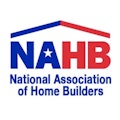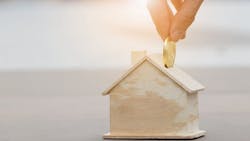NAHB Policy Briefing: Home Resiliency Programs May Help Lower the Cost of Homeowners Insurance
This article first appeared in the July/August issue of Pro Builder.
Natural disasters have been increasing in frequency and severity over the last decade. At the same time, state insurance regulators have struggled to address the challenges associated with inadequate insurance coverage and excessive premiums for single-family and multifamily dwellings.
As a result, home insurance costs nationwide have spiked nearly 20% over the past two years, and diminished insurance options have curtailed new home construction in some places.
To address this growing challenge, the National Association of Home Builders (NAHB) is asking states to consider reducing homeowners insurance premiums for structures built to modern codes or buildings that are constructed or renovated to meet the higher standards of a home resiliency program.
Studies demonstrate that homes built to building codes developed since the year 2000 are significantly more resilient to natural disasters than homes built to prior codes.
Home resiliency programs go a step further, encouraging home builders, remodelers, and home owners to voluntarily build or upgrade to above-code standards that yield even more disaster-resistant homes.
Examples of these above-code programs include the National Green Building Standard (NGBS) Green +RESILIENCE Certification and the Insurance Institute for Business & Home Safety (IBHS) FORTIFIED program. Several states have also developed above-code programs to incentivize voluntary retrofits for resilience, and HUD has developed Resilience Guides to help builders and homeowners get started.
RELATED:
- Homeowners Insurance: The Other Affordability Crisis
- Design Best Practices for Stronger, More Durable New Homes
- 7 Ways to a Wildfire-Prepared Home
The National Green Building Standard
NGBS Green +RESILIENCE Certification is recognized by HUD’s Green Resilient Retrofit Program (GRRP), which provides funding for direct loans and grants to fund projects that promote green building practices.
NGBS is managed by the Home Innovation Research Labs in partnership with the National Association of Home Builders (NAHB) and the International Code Council (ICC). It is an ANSI-approved, third-party certified standard for residential green building.
NGBS offers Green Certifications in building, remodeling and land development, which are recognized by many federal, state and local agencies, as well as lenders, the Appraisal Institute and code officials.
To earn the +RESILIENCE certification, builders must demonstrate that their home provides “at least 30% enhanced resilience and durability beyond the structural requirements of the IBC or IRC.”
The NGBS Resilient Construction Sections were intentionally written to be a design-based performance metric, as opposed to a prescriptive checklist of best practices. The resilient construction practices allow resilience to be more customized for the specific project, weather conditions, and natural hazards in the local area.
The Insurance Institute for Business & Home Safety
IBHS is an independent, nonprofit organization funded by property insurers and reinsurers. The Institute provides resources and guidance for homeowners on fortifying their home to withstand extreme weather, and the IBHS Research Center conducts realistic weather simulations to evaluate the structural design of their FORTIFIED roofing and building standards.
The IBHS FORTIFIED program is designed to strengthen homes and commercial buildings against specific types of severe weather such as high winds, hail, hurricanes and tornadoes.
FORTIFIED offers three levels: Roof, Silver and Gold. The highest level of certification under the program, FORTIFIED Gold, goes beyond the above-code requirements of the Roof and Silver levels. It requires an engineered, continuous load path, which is a specific plan that specifies how the roof should be fixed to the walls, and how the walls should be anchored to the foundation. The specifics include:
- Engineered Wall-to-Foundation Connections;
- Engineered Roof-to-Wall Connections;
- Engineered Story-to-Story Connections;
- Pressure-rated Windows & Doors (hurricane prone areas only); and
- Stronger Exterior Sheathing (hurricane prone areas only).
In some states, homes built and certified to the FORTIFIED Gold standard may enjoy a significant discount on the cost of homeowners insurance.
“NAHB is encouraging the insurance industry to develop sensible, data-driven reductions in insurance premiums for new homes built to modern codes, as well as those that meet above-code resilience standards, such as the NGBS’ Green +RESILIENCE Certification or the IBHS FORTIFIED program” says Susan Asmus, NAHB’s Senior VP for Regulatory Affairs.
About the Author

National Association of Home Builders
The National Association of Home Builders (NAHB) is a Washington, D.C.-based trade association representing more than 140,000 members involved in home building, remodeling, multifamily construction, property management, subcontracting, design, housing finance, building product manufacturing, and other aspects of residential and light commercial construction. For more, visit nahb.org. Facebook.com/NAHBhome, Twitter.com/NAHBhome
